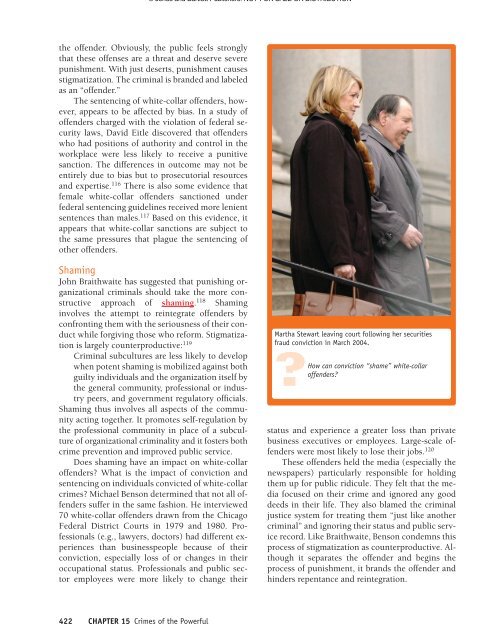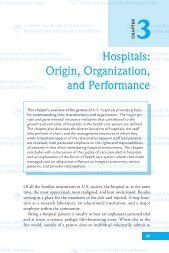CHAPTER - Jones & Bartlett Learning
CHAPTER - Jones & Bartlett Learning
CHAPTER - Jones & Bartlett Learning
Create successful ePaper yourself
Turn your PDF publications into a flip-book with our unique Google optimized e-Paper software.
30017_CH15_398_431_r7.qxp 4/7/06 3:14 PM Page 422<br />
© <strong>Jones</strong> and <strong>Bartlett</strong> Publishers. NOT FOR SALE OR DISTRIBUTION<br />
1<br />
2<br />
3<br />
4<br />
5<br />
6<br />
7<br />
8<br />
9<br />
10<br />
11<br />
12<br />
13<br />
14<br />
15<br />
16<br />
17<br />
18<br />
19<br />
20<br />
21<br />
22<br />
23<br />
24<br />
25<br />
26<br />
27<br />
28<br />
29<br />
30<br />
31<br />
32<br />
33<br />
34<br />
35<br />
36<br />
37<br />
38<br />
39<br />
40<br />
41<br />
42<br />
43<br />
44<br />
45<br />
46<br />
47<br />
48<br />
49<br />
50<br />
51<br />
52<br />
the offender. Obviously, the public feels strongly<br />
that these offenses are a threat and deserve severe<br />
punishment. With just deserts, punishment causes<br />
stigmatization. The criminal is branded and labeled<br />
as an “offender.”<br />
The sentencing of white-collar offenders, however,<br />
appears to be affected by bias. In a study of<br />
offenders charged with the violation of federal security<br />
laws, David Eitle discovered that offenders<br />
who had positions of authority and control in the<br />
workplace were less likely to receive a punitive<br />
sanction. The differences in outcome may not be<br />
entirely due to bias but to prosecutorial resources<br />
and expertise. 116 There is also some evidence that<br />
female white-collar offenders sanctioned under<br />
federal sentencing guidelines received more lenient<br />
sentences than males. 117 Based on this evidence, it<br />
appears that white-collar sanctions are subject to<br />
the same pressures that plague the sentencing of<br />
other offenders.<br />
Shaming<br />
John Braithwaite has suggested that punishing organizational<br />
criminals should take the more constructive<br />
approach of shaming. 118 Shaming<br />
involves the attempt to reintegrate offenders by<br />
confronting them with the seriousness of their conduct<br />
while forgiving those who reform. Stigmatization<br />
is largely counterproductive: 119<br />
Criminal subcultures are less likely to develop<br />
when potent shaming is mobilized against both<br />
guilty individuals and the organization itself by<br />
the general community, professional or industry<br />
peers, and government regulatory officials.<br />
Shaming thus involves all aspects of the community<br />
acting together. It promotes self-regulation by<br />
the professional community in place of a subculture<br />
of organizational criminality and it fosters both<br />
crime prevention and improved public service.<br />
Does shaming have an impact on white-collar<br />
offenders? What is the impact of conviction and<br />
sentencing on individuals convicted of white-collar<br />
crimes? Michael Benson determined that not all offenders<br />
suffer in the same fashion. He interviewed<br />
70 white-collar offenders drawn from the Chicago<br />
Federal District Courts in 1979 and 1980. Professionals<br />
(e.g., lawyers, doctors) had different experiences<br />
than businesspeople because of their<br />
conviction, especially loss of or changes in their<br />
occupational status. Professionals and public sector<br />
employees were more likely to change their<br />
Martha Stewart leaving court following her securities<br />
fraud conviction in March 2004.<br />
?How can conviction “shame” white-collar<br />
offenders?<br />
status and experience a greater loss than private<br />
business executives or employees. Large-scale offenders<br />
were most likely to lose their jobs. 120<br />
These offenders held the media (especially the<br />
newspapers) particularly responsible for holding<br />
them up for public ridicule. They felt that the media<br />
focused on their crime and ignored any good<br />
deeds in their life. They also blamed the criminal<br />
justice system for treating them “just like another<br />
criminal” and ignoring their status and public service<br />
record. Like Braithwaite, Benson condemns this<br />
process of stigmatization as counterproductive. Although<br />
it separates the offender and begins the<br />
process of punishment, it brands the offender and<br />
hinders repentance and reintegration.<br />
422 <strong>CHAPTER</strong> 15 Crimes of the Powerful<br />
1st pass Pages

















